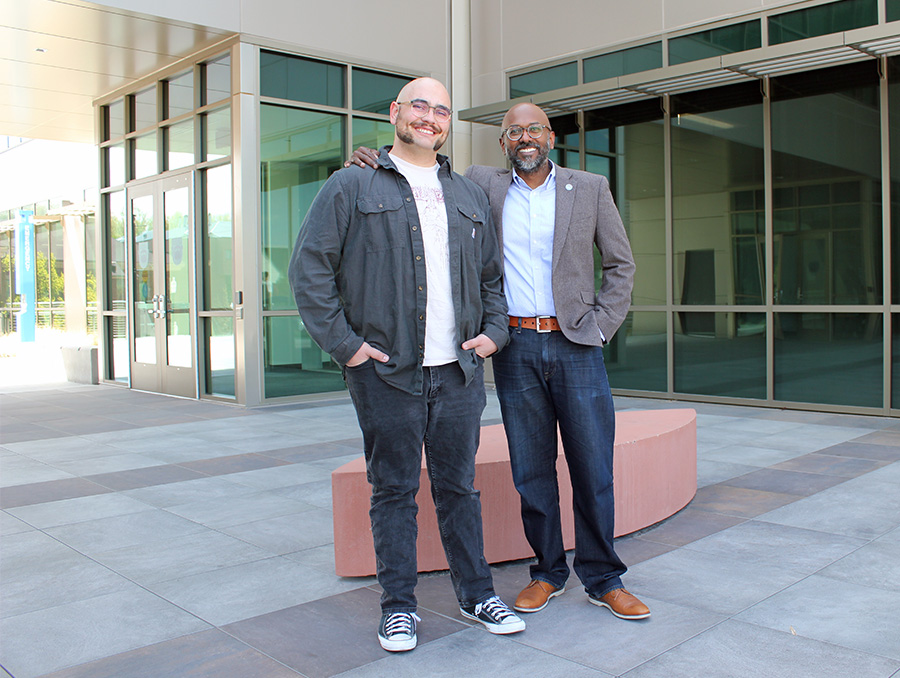Graduate student Thomas Selmi spends his time in the lab working on molten salt —designed to be used in nuclear reactors — and the U.S. Department of Energy wants to keep it that way.
Selmi has received the DOE University Nuclear Leadership Program Fellowship, which provides $169,000 over three years to support his doctoral research relevant to nuclear energy as well as a summer internship at a DOE national lab or approved facility.
“It’s a really special opportunity,” Selmi said.
Currently a research assistant for Chemical & Materials Engineering Professor Dev Chidambaram, Selmi said the fellowship has validated the significance of the research he is currently pursuing in Materials Science & Engineering at the University of Nevada, Reno. He is set to finish his master’s degree in December 2024.
“Thomas is one of the brightest and capable students I have come across,” Chidambaram said. “While I was told by my colleagues that Thomas is one of the top graduating undergraduate students, I experienced that first-hand when he started working in my lab in January of last year. Our nation needs bright engineers like Thomas to maintain our scientific leadership in the 21st century and I am glad to have the opportunity to mentor him on his doctoral dissertation.”
Selmi is the fifth student in the Materials Science Engineering program to receive this competitive fellowship over the past five years: three of them worked with Chidambaram and one with Associate Professor Krista Carlson.
Next-gen nuclear power
Selmi’s path to nuclear energy had some twists and turns, but eventually brought him to Chidambaram’s Materials and Electrochemical Research (MER) lab. There, he works on molten salts: salts that have been heated to temperatures as high as 1,200oF to melt them. Under those conditions, the salts have unique properties that make them attractive for nuclear power.
Currently, most commercial nuclear reactors in the United States are Generation II reactors based on water (LWRs). Molten salt reactor (MSR) designs are the next generation (Generation IV) reactors that are under development, Selmi said. Among other advantages, MSRs operate at atmospheric pressure while LWRs operate at high pressures. Additionally, MSRs will allow reactors to operate at much higher temperatures and at vastly improved efficiencies.
While the DOE built a prototype MSR in the 1960s and led in this technology, Chidambaram noted that the country has lost a lot of capability in the ensuing period. Chidambaram and Selmi explained that the United States is experiencing a nuclear resurgence that has led to the commercial development of MSRs and the need for a scientific and technical capability.
Nuclear power plants in the United States currently do not use this technology, although it is being explored. The Nuclear Regulatory Commission in December 2023 issued a construction permit for a non-power test reactor in Oak Ridge, Tennessee, that will use molten salt to cool the reactor core.
‘Molten salts — that sounds cool’
Selmi’s work with molten salt focuses specifically on identifying and quantifying moisture in salt. Salt is corrosive, and moisture makes it more corrosive. Understanding how the salt corrodes materials at high temperatures and how that will be affected by varying moisture content will help ensure that molten salt nuclear reactors work properly and safely, avoiding any unexpected accidents and shutdowns.
Chidambaram got Selmi interested in that particular area of nuclear energy.
“When I first talked to Dr. Dev, he gave me an idea of the MER lab projects,” Selmi said.
One stood out.
“I said, 'molten salts — that sounds cool,'” Selmi recalled.
That and the state-of-the-art analytical and electrochemical capabilities the MER lab made it a no-brainer for Selmi to continue to pursue his Ph.D. at the University under Chidambaram’s guidance.
Now it might become his life’s work: After graduation, Selmi said he would be interested in continuing to work on molten salts at a DOE national lab.
But that wasn’t always the plan: Selmi had a wide range of internships and jobs before arriving at Chidambaram’s lab, including two with Nevada Gold Mines in Elko — one in process operations and the other in metallurgical engineering. He also had a research-and-development internship with Dragonfly Energy, a Reno-based company that works on lithium-ion battery projects and battery technology.
“That’s when I learned that I really liked to do research,” he said.
He worked construction in high school, where he said he learned “hands-on, practical skills, like how to build things.”
He recommends a broad experience to up-and-coming engineers who aren’t sure which niche is right for them.
Eventually, something will sound cool.















